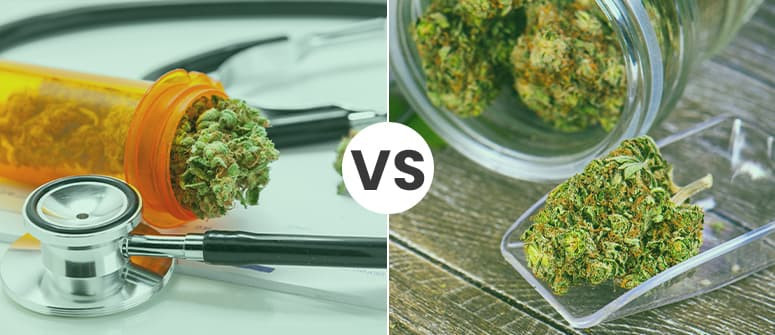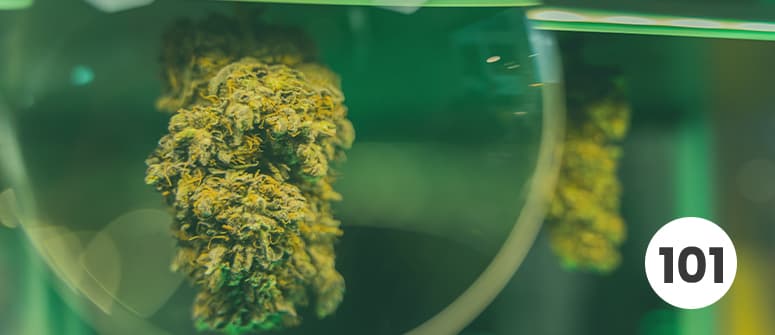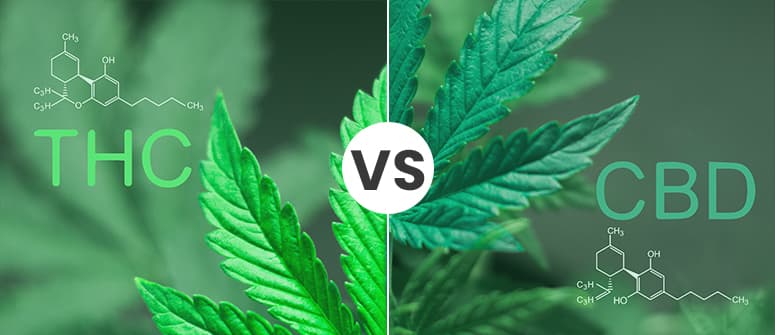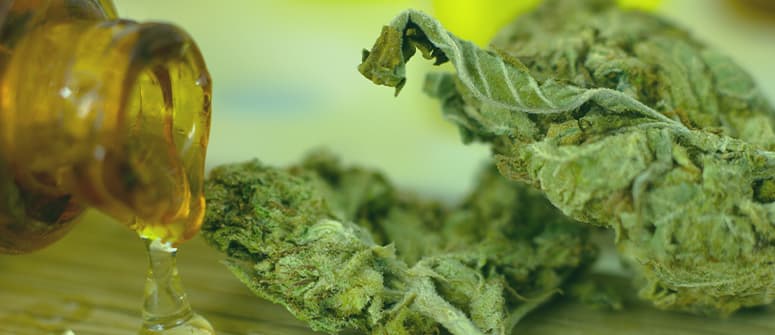Medical vs recreational marijuana - what's the difference?

Published
While it is not possible to determine whether a cannabis strain is “medical” or “recreational” based on genetics or cannabinoid content alone, there are increasingly common regulations around cultivation and production that determine these titles. Find out the key differences.
Contents:
As cannabis legalization starts to become a reality in Europe (and elsewhere), we are beginning to see a differentiation, at least in terminology, between medical marijuana and recreational cannabis. Is there a difference, though? After all, a plant is a plant.
The distinction between medical and recreational marijuana is not easy to make. Cannabis has been used for thousands of years, both as a medicine and for pleasure. Ultimately, it's the intent of the user that makes the difference, on a personal level.
In a commercial environment, however, there are in fact increasingly formal distinctions between cannabis intended for medical vs recreational use—even if a recreational user could consume medical cannabis and obtain the same effect, and vice versa.
CANNABIS 101: TERMINOLOGY

While many people believe that the two kinds of cannabis are interchangeable, in an increasingly regulated world, there is a vast difference between recreational and medical weed.
A plant is no longer just a plant. Cultivation environment and conditions, as well as the entire processing chain, all play a role in the nomenclature of cannabis. So, what is medical marijuana, and what is recreational marijuana?
WHAT IS MEDICAL MARIJUANA?
In its broadest meaning, medical marijuana is cannabis used by patients to address medical conditions. Though it appears in different forms, one thing that links all dedicated medical marijuana products is a focus on quality and regulation.
For example, Germany boasts one of the largest and most developed medical cannabis markets. Here, the process of growing medical marijuana must adhere to GACP regulations (good agricultural and collection practice) and EU GMP (good manufacturing practice), as well as meet the requirements of the revised version of the DAB monograph (which concerns cannabis extracts).
As a result, medical cannabis can be considered, in some contexts, that which undergoes stringent quality control and is indicated solely for use among patients.
It's worth noting that some people consider the term “marijuana” to be appropriate only for recreational use, but the reality is that terms like this do not make a difference—formal certifications do.
WHAT IS RECREATIONAL CANNABIS?
Recreational cannabis is just that—cannabis used for recreational purposes. The term can be used to describe any kind of cannabis, though it chiefly centres on enjoying THC-rich strains for pleasure, socialising, and creative inspiration.
In terms of formal distinctions, recreational cannabis may undergo different types of quality control measures than medical marijuana, depending on location.
In legal environments in North America, some specific regulations do apply. Although many of these centre on the hemp market, certain ones extend to recreational use, and ensure that commercially grown crops meet strict standards of quality control. In any legal market, all cannabis sold, for any purpose, has to meet a baseline level of quality. In areas where only medical cannabis is legal, however, recreational weed sourced from the black market can vary significantly in quality.
RECREATIONAL CANNABIS VS MEDICAL MARIJUANA: WHAT’S THE DIFFERENCE?

Essentially, aside from intended use, the difference between medical and recreational cannabis is the certifications that it has—basically, how it's grown, cured, processed, and then manufactured into other products. From there, the main distinction lies in how it’s accessed, and by whom.
In the United States, where there is no federal reform, the distinction is more nebulous, though this is subject to change.
In Europe, there's a changing landscape. At present, Holland only has one manufacturer that produces medical-grade, EU GMP cannabis. However, it mostly ships over the border to Germany (although some goes to the UK and Israel). The coffeeshop infrastructure, however, is not EU GMP, but rather set up to comply with food-grade regulations.
It is unknown, however, how the transition to the recreational market will be handled. It could be that EU GMP cannabis is allowed to be imported as a pharmaceutical product and then sold on the recreational market. But this is conjecture at the moment.
In what follows, we shed some light on the distinctions—whether rigid or transient—that separate medical marijuana and recreational weed, to help you decide which type may be best for you.
CANNABINOID CONTENT
Some describe medical cannabis as weed containing high levels of CBD, and recreational cannabis as weed rich in THC. This, however, is misleading, as both THC and CBD can be used for medical purposes.
Indeed, certain approved pharmaceutical cannabis products contain both cannabinoids. In the case of Sativex, an oromucosal spray approved for patients with multiple sclerosis, CBD and THC are represented in equal measure.
However, in other cases, formulas harness exclusively CBD or THC. For example, Epidiolex is an approved form of pharmaceutical CBD indicated for children with rare forms of severe epilepsy. This formula contains no THC, which makes sense, as even in the therapeutic sense, THC is capable of causing a psychotropic effect.
On the other hand, dronabinol, a form of synthetic THC, is indicated for patients experiencing nausea and vomiting from chemotherapy or anorexia associated with AIDS.
Furthermore, cannabinoids like THCV, CBDA, and CBG, among others, are being invoked for their potential medical prowess, and open up the field further for development in the medical cannabis arena.
When it comes to recreational cannabis, THC reigns supreme, as it’s responsible for producing that euphoric, uplifting effect users enjoy, whether solo or with friends. Although some prefer strains with super-high levels of THC, others enjoy those containing THC alongside CBD or other cannabinoids, to add a well-rounded element to their high. So here too, recreational weed cannot be considered just one cannabinoid.
It is worth noting that many of the approved cannabis pharmaceuticals out there use synthetic cannabinoids. As opposed to being derived from the cannabis plant directly, these cannabinoids are made in a lab. Though they have a very similar structure to natural phytocannabinoids, synthetic cannabinoids may exhibit slightly different pharmacological effects and side effects. That said, legal synthetic cannabinoids are produced in certified facilities under strict quality control measures.
Illegal synthetics, however, can be very dangerous and should be avoided, no matter what the individual intends to use them for.
PURPOSE OF USE
The reality is that many recreational users actually use the plant for wellness purposes in addition to the pleasure they get from being high. Furthermore, those using cannabis medically may themselves appreciate the psychoactive effect exhibited by THC.
In terms of a legal definition, medical users are those who have been prescribed cannabis by a doctor for a specific condition, or are equipped with a medical marijuana card with which to purchase medical cannabis from a dispensary.
ACCESSIBILITY
Depending on where you live, access to medical and/or recreational cannabis can vary widely.
In the US, for example, medical users can obtain special cards that allow them to buy cannabis from dispensaries. Adults without medical cards must go to recreational outlets and buy at a higher price.
In Holland, after the insurance industry stopped compensating patients in 2017, many medical users were forced to buy their cannabis from coffeeshops (like recreational users). In Germany, being a patient theoretically means that your monthly supply for a diagnosed medical condition is reimbursed by health insurance.
CBD is now legal in most European countries. Unless it is prescribed by a doctor, however, people must cover the cost of it themselves.
Of course, in areas where no form of cannabis is legal, it may not be possible to source medical-grade marijuana at all. In that case, buying street weed in an attempt to use it for therapeutic purposes is the closest some get to accessing medical cannabis.
CULTIVATION
Cultivation is one of the few areas where it is easier to determine the difference between medical vs recreational weed, at least in Europe.
In the EU, a crop must be grown indoors, with very specific divisions between grow rooms, and certified EU GMP, to be considered "medical". Adult use, recreational weed can be grown outside, but it must be tested to ensure it doesn't contain heavy metals or toxic pesticides.
Matters are a bit more complicated overseas, but generally, medical cannabis undergoes much stricter cultivation and processing requirements to be approved than recreational.
Interestingly, industrial hemp can be cultivated practically anywhere. However, because the plant is very good at absorbing heavy metals, crops grown in this manner cannot be used for human consumption.
QUALITY
While it can be easy to assume medical weed will be of substantially higher quality than weed used recreationally, this isn’t always the case. Because cultivation and processing vary so widely around the world, quality becomes more about individual producers, companies, and products as opposed to broad generalisations.
Of course, given the more stringent controls medical cannabis is subject to from seed to sale, one could say that the quality is likely to be higher, as the threat of contaminants is lower.
RECREATIONAL CANNABIS VS MEDICAL MARIJUANA: WHICH ONE SHOULD YOU PICK?

When it comes to choosing between the two types of cannabis, there are several factors to consider.
The first is affordability. If you have a medical condition, and your doctor is willing to prescribe you cannabis, this is clearly the best choice for your back pocket. Going this route and obtaining a medical cannabis card will also help to protect you from overzealous law enforcement.
The second is preference. If you are a recreational user who loves to get high on the weekends, the “grade” of cannabis is less important, but rather the kind of cultivar you choose.
No matter what, however, both recreational and medical cannabis users should have safe, secure access to marijuana grown in sanitary conditions (at minimum) with proper testing and labelling.



